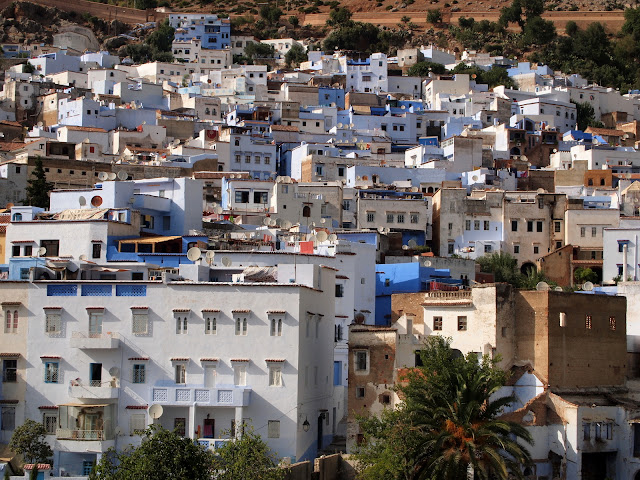The colors of Moroccan life are often dazzlingly vibrant. Women dress in brightly-dyed clothing, textiles glow in intense hues, and pottery is painted in all colors of the rainbow. But the dry scenery that currently passed by outside my train window was decidedly more muted. Ever since departing from Rabat two hours prior, it seemed as if the sun's scorching heat had washed all the Earth's features in the same shade of dust. Soon, however, the landscape grew dramatic. The ragged foothills of the highest mountains in Northern Africa enveloped us. Our fabled destination then came into view. The imperial city of Meknes awaited.
 |
| Bab al-Mansour, gate outside the imperial city of Meknes |
Meknes was the seat of power in Morocco in the late seventeenth and early eighteen centuries. Much of the remarkable Spanish-moorish architecture and urban design that dates from this period has been preserved. In addition, the craftsmanship on display in some buildings here is simply jaw-dropping. One trip to Meknes is proof enough: Morocco is home to some of the most exquisite building interiors ever created.

It's one thing to admire the artistry of a different age. But what really makes Morocco unique is the depth to which the traditional arts have been kept alive. From woodworking to ceramics, leather-making to metalworking, centuries-old techniques are still practiced here by legions of skilled artisans. A walk around the old city of Meknes reveals some of the fruits of some of these crafts. However, the city's larger and more famous neighbor of Fes is home to even more treasure.
 |
| Wood workshop in Meknes |
 |
| Brassware shop in Fes |
Fes, another former imperial capital of Morocco, lies just 30 miles to the east of Meknes. Fes is famous for one, very special reason. It is home to Fes el-Bali, the best-preserved, most vibrant medieval city in the entire world. Despite being over 1000 years old and having no tall residential buildings, Fes el-Bali remains one of the most densely populated areas on Earth. Nearly 200,000 people live inside a small area that has sheltered untold generations of their ancestors. A visit here truly feels like taking a trip back in time.
My first attempt to navigate Fes el-Bali proved to be a bewildering experience. I initially tried to use a map, but quickly realized the futility of this endeavor. The 9,000 streets inside of the labyrinth-like old city twist and turn unexpectedly, often leading to dead-ends. These narrow passages are completely devoid of motorized vehicles, making Fes el-Bali the largest urban car-free zone on the planet. The only non-human form of transport present are donkeys, which navigate congested markets to their owners cries of "Balak!" ("Look Out!")
A couple of hours of lost wandering through Fes-el Bali left me reeling, in a state of culture shock that rivaled even that of India. My senses were completely overloaded by the exotic sights, smells, and sounds that greeted me around every corner. This feeling was all the more remarkable given the city's close proximity to Europe. It would be entirely possible to have an early breakfast in Southern Spain, take the ferry to Morocco, hop in a car, and arrive in Fes in time for lunch!
 |
| Fes-el Bali as seen from neighboring hill |
While visiting Fes was a singular experience, after two days I was ready to escape the claustrophobia-inducing old city and go somewhere less crowded. So it was that I found myself on a bus heading north, towards Morocco's stunningly-situated city of Chefchaouen.
 |
| Chefchaouen |
Chefchaouen was established in the 15th century by Moors and Jews that had fled Spain during the height of the Reconquista. They built the city in a defensive position high up in the rugged Rif mountains, an ideal spot for repelling invasions. During the 20th century many streets and buildings were painted a distinct shade of pastel blue. This pleasing aesthetic feature, combined with the city's picturesque location, have made Chefchaouen one of the most popular tourist destinations in Morocco.
The plethora of tourist-oriented hotels, restaurants, and shops inside of Chefchaouen have thankfully done little to dim the city's laid-back charm. I found it a magical experience to meander through its narrow, blue-washed streets, amongst smiling locals going about their daily lives.
I was fortunate to be friends with one of Chefchaouen's own. I'd met Abdenour several years ago when we both resided in Washington, D.C. He had recently returned to live in the city of his birth, and was happy to offer me the kind hospitality that Moroccans are known for. He invited me to his home to dine on delicious Moroccan food, offered me a place to sleep, gave me a tour of the region in his car, and helped me purchase gifts for friends and family back home. Truly, Abdenour went above and beyond the customary obligations of host, and his generosity is one of things that I will remember most fondly when I recall my time in this beautiful country.
 |
| Breaking the fast of Ramadan in Abdenour's home |
***
As the bus pulled away from Chefchaouen, my mind turned towards the future. I'd be flying home in a little less than a week, something that seemed unreal considering that I'd been away for more than a year.
I only had a few more days remaining in Morocco. The most important thing left on the agenda was to finish buying gifts. I wanted to find items that offered a small sample of the rich colors I'd experienced here. But i realized this would be a poor stand-in for the real thing. After all, there's little substitute for seeing something with your own eyes, isn't there?
*******













No comments :
Post a Comment